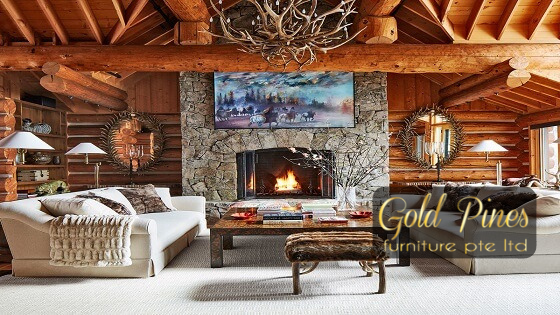Rustic design describes the range of styles with an emphasis on unrefined, natural beauty. It is drawn from natural inspiration, utilizing elements like raw wood, wrought metals, stone, and plenty of plants.
Some variations might come with bright natural colors, but the main objective of a rustic design is to create an interior that resembles the simplicity and beauty found in the outside world of nature.
The philosophy behind rustic design is relatively simple. It embraces earthy colors and natural textures, infusing your home with comfort and warmth. You might now wonder what are some of the principles of rustic design, right? Let us get you covered in this article!
Furniture
Rustic furniture makes liberal use of raw wood to create an earthy and natural look. Distressed and reclaimed wood make solid, aesthetically beautiful furniture that looks handmade and natural. Wide, wood flooring is usually seen, complementing the wood beams typically used to support the ceilings.
Apart from that, wrought metals and unfinished iron are often used as accents and highlights. Depending on your tastes, these metals may be incorporated into your space in various ways such as chandeliers, ceiling lamps, door knobs, and so on. Pots and pans tend to be seen hanging in the kitchen while cast iron bands are spotted wrapped around staircase posts.
Finally, stone is commonly used to balance the interior and complete the rustic design. Exposed walls are typically seen surrounding fireplaces allowing nature’s elements — fire, stone and wood — to unite and beautify the room. Speaking of which, big windows that allow in large amounts of natural lighting also do wonders for the rustic aesthetic.
Colors
Rustic design is pretty versatile when it comes to colors. The color palette employed in rustic aesthetic ranges from the usual brown, beige, cream to the bright, striking colors of green, blue, and red. In any case, there are no restriction as long as the colors tie in with the other elements and lead to a warm atmosphere.
To help capture the basic feel of a rustic home, large surfaces such as the walls and floors are typically left raw and unpainted. However, color is often included to complement the natural materials of a room. If selecting colors is a difficult decision to make, you can go for white because it is the safest solution and will not fail to support the desired look.
Textiles & Patterns
When it comes to textiles, rustic design incorporates sturdy fabrics that evoke a natural aesthetic. Different textiles are often placed side-by-side, leading to a complex but stylish room. For instance, leather, furs, linen and weave are excellent additions to add accent, flavor, and quality of life to any setting. These textures can be expressed in the form of throws, curtains, cushions and other accessory items.
Pattern-wise, since most surfaces and objects are kept simple and unrefined, they are responsible to prompt interest. A rustic home can be enhanced with handmade, patch-worked blankets, pillow cases or floor rugs. In vibrant colors and various patterns, they are able to support the right look and feel and match the surrounding weathered elements, bringing down-home comfort to the space.
In any case, rustic design is meant to look effortless, which means your interior needs nothing more than these elements to instill the space with a sense of warmth and coziness. This design style simply accentuates the authentic beauty of natural materials, celebrates the simple tastes and makes us feel at home.
Conclusion
To reiterate, rustic design embraces nature-inspired textures, simple and earthy colors, and ultimately organic warmth. While rustic style in its most traditional sense might appear heavy & dark today, a modern rustic style has emerged in recent years that feels both fresh and real, light and grounded.
Rustic interiors have a sense of connection to the past that’s hard to resist. They feel honest and unstudied and evoke a simpler time. As the art of re-purposing is much celebrated, they provide a wonderful showcase for ingenuity. In a world where so much is virtual, they are boldly, blatantly real.
Simply put it, rustic design is a great way to connect or reconnect with nature elements and benefit from her soothing powers. If you seek to return to a warm and comfortable home, then look no further than rustic.






